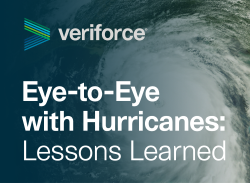By James Junkin, CSP, MSP, SMS, ASP, CSHO
Last year, the Atlantic Hurricane season produced fourteen named storms, eight classified as hurricanes with winds of 74 mph or greater. Due to the culmination of decades of increasing intensity, frequency, and duration of severe storms, this phenomenon results from rising ocean sea surface temperatures caused by global warming and other human-caused environmental changes.
My knowledge of hurricanes is not scientific but personal.
I have lived through the consequences of four large hurricanes — Katrina, Gustav, Isaac, and Ida — and am still managing the aftermath of the latter. I moved 135 miles away from the coast after Katrina destroyed my home in St. Bernard Parish, Louisiana, and Hurricanes Gustav and Isaac caused roof and flood damage after we rebuilt. I wasn’t expecting another storm when Ida’s strong inland winds struck my new home in Hammond, Louisiana, too.
Hurricane Katrina: A first ‘once-in-a-lifetime’ storm
In August 2005, Hurricane Katrina hit the southeastern coast of the United States and was soon after ranked as the costliest natural disaster in U.S. history—the cost: 1,800 lives, and $160 billion in property and infrastructure damage.
Hurricane Katrina’s devastation on the city of New Orleans was actually not a direct result of the storm’s strong winds; it was the inability of the city’s levee systems that held back the waters of Lake Pontchartrain and Lake Borgne to withstand the surge. At the same time, the storm was so powerful that it turned the current of the Mississippi River northbound, surging water back into the industrial canal and putting pressure on its levees. By August 30, 80% of the city was underwater.
My neighborhood of St. Bernard Parish started flooding 24 hours before the levee at the canal gave way. My home, like so many others, was completely destroyed.
Surviving the storm is the first challenge, but recovery is just as devastating an experience. Every structure in New Orleans had extensive water and roof damage. The city lost power. When the water subsided, you were left with mold and rotting food. A nearby oil spill, combined with sewage and bacteria-rich floodwaters, created a public health emergency. It took 43 days to pump the floodwaters out of the city, and the city’s population has yet to fully recover to its pre-Katrina numbers.
My lessons learned for business owners in hurricane territories
Preparation is everything. Here are three best practices I recommend for residents and businesses residing in coastal regions:
- Know when to leave. During hurricane season, it’s important to stay apprised of what’s building in your area. Heed the warnings of local officials and check websites like your local National Weather Service and local government emergency management offices. Download the FEMA app to get real-time alerts. Know your evacuation plan, have emergency items packed, and be ready to go.
- Create a hurricane preparedness plan. The Occupational Safety and Health Administration (OSHA) has developed standards to help organizations develop thoughtful, well-organized strategies for employer and employee actions during workplace emergencies. These requirements are designed to avoid confusion, injury, and property damage. OSHA 1910-38 Emergency Action Plan requires that emergency plans be both written and communicated orally to your entire staff, and include several procedures including:
- Reporting an emergency.
- Evacuation and exit routes.
- Accounting for all employees after evacuation.
- Train your employees. You are responsible for informing and training your employees, including contract and temporary workers, on the hazards, protocols, and backup plans for your facility. Focus on:
- Ensuring that all workers know what to do in case of an emergency. This means communicating in a way that considers literacy, cultural, and language barriers that exist within your workforce.
- Practicing evacuation plans. Practice makes perfect, or at least builds familiarity and automatic reaction before a true emergency takes place.
- Updating your plans and procedures based on lessons learned. If you discover a flaw in your plan during a practice run or a nearby incident provide insight, change the plan, and then communicate this change to your workforce.
The Occupational Safety and Health Administration (OSHA) recommends you include the location of the nearest hospital or emergency medical center, the type of alarm system used to notify employees of an emergency, procedures for accessing information, and communication plans in your emergency plans. Even with today’s tools and technologies, hurricane season is still wildly unpredictable. Contact a Veriforce specialist to learn more about hurricane preparedness.

